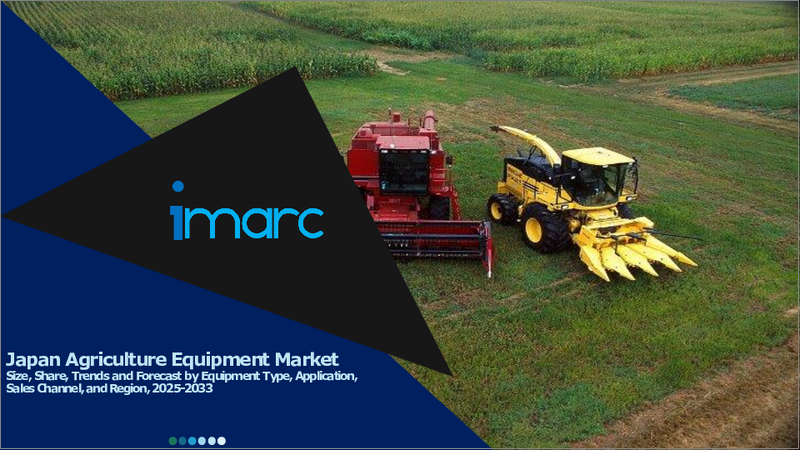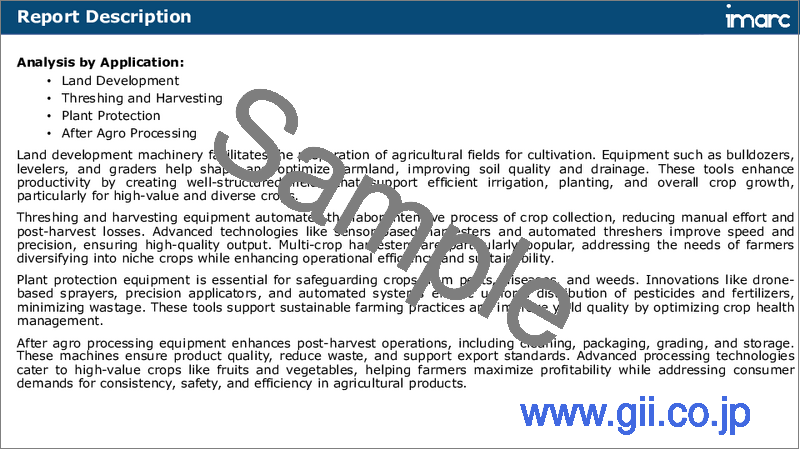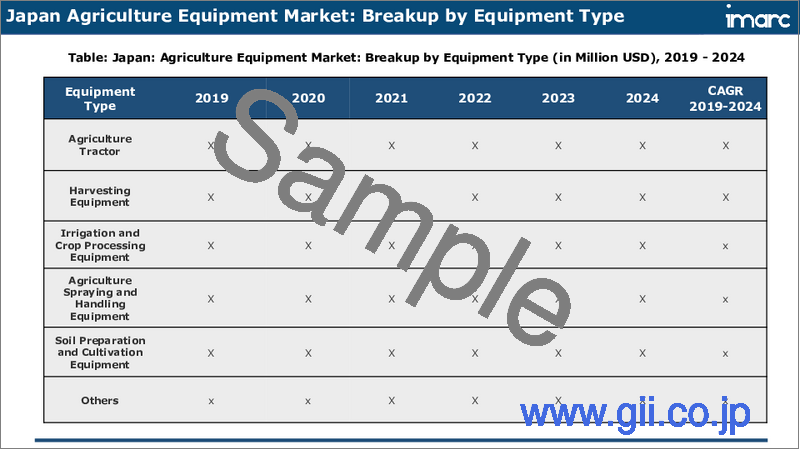|
|
市場調査レポート
商品コード
1609692
日本の農業機械市場レポート:機器タイプ、用途、販売チャネル、地域別、2025年~2033年Japan Agriculture Equipment Market Report by Equipment Type, Application, Sales Channel (Original Equipment Manufacturers, Aftermarket), and Region 2025-2033 |
||||||
カスタマイズ可能
|
|||||||
| 日本の農業機械市場レポート:機器タイプ、用途、販売チャネル、地域別、2025年~2033年 |
|
出版日: 2024年12月05日
発行: IMARC
ページ情報: 英文 122 Pages
納期: 5~7営業日
|
全表示
- 概要
- 目次
日本の農業機械市場の市場規模は2024年に108億米ドルに達しました。今後、IMARC Groupは、市場は2033年までに135億米ドルに達し、2025~2033年の成長率(CAGR)は2.5%になると予測しています。生産性を向上させ、耕作が困難な地域を耕作するための最適な機械に対する農家の需要の増加が、主に市場成長の原動力となっています。
本レポートで扱う主な質問
- 日本の農業機械市場はこれまでどのように推移し、今後どのように推移するのか?
- COVID-19が日本の農業機械市場に与えた影響は?
- 日本の農業機械市場の機器タイプ別の内訳は?
- 日本の農業機械市場の用途別の内訳は?
- 日本の農業機械市場の販売チャネル別の内訳は?
- 日本の農業機械市場のバリューチェーンにはどのような段階がありますか?
- 日本の農業機械の主な促進要因と課題は何か?
- 日本の農業機械市場の構造と主要プレーヤーは?
- 日本の農業機械市場における競合の程度は?
目次
第1章 序文
第2章 調査範囲と調査手法
- 調査の目的
- ステークホルダー
- データソース
- 市場推定
- 調査手法
第3章 エグゼクティブサマリー
第4章 日本の農業機械市場:イントロダクション
- 概要
- 市場力学
- 業界動向
- 競合情報
第5章 日本の農業機械市場情勢
- 過去および現在の市場動向(2019年~2024年)
- 市場予測(2025-2033)
第6章 日本の農業機械市場:機器タイプ別の内訳
- 農業用トラクター
- 収穫機器
- 灌漑および作物処理機器
- 農業用散布およびハンドリング機器
- 土壌調整および耕作設備
- その他
第7章 日本の農業機械市場:用途別の内訳
- 土地開発
- 脱穀と収穫
- 植物保護
- 農産物加工後
第8章 日本の農業機械市場:販売チャネル別の内訳
- オリジナル機器製造会社(OEM)
- アフターマーケット
第9章 日本の農業機械市場:競合情勢
- 概要
- 市場構造
- 市場プレーヤーのポジショニング
- 主要成功戦略
- 競合ダッシュボード
- 企業評価象限
第10章 主要企業のプロファイル
第11章 日本の農業機械市場:業界分析
- 促進要因・抑制要因・機会
- ポーターのファイブフォース分析
- バリューチェーン分析
第12章 付録
Japan agriculture equipment market size reached USD 10.8 Billion in 2024. Looking forward, IMARC Group expects the market to reach USD 13.5 Billion by 2033, exhibiting a growth rate (CAGR) of 2.5% during 2025-2033. The increasing demand among farmers for optimal machines to improve productivity and farm hard-to-access areas is primarily driving the market growth.
Agricultural equipment are utilized for a multitude of tasks in farming, including the harvesting of crops, field spraying, seed planting, land preparation, cattle breeding, and livestock feeding. They encompass a range of machinery such as mowers, backhoes, harrows, cultivators, rakes, tractors, combine harvesters, sprayers, chain saws, brush cutters, and sawmills. The use of agricultural equipment serve to enhance the efficiency and productivity of farming operations by reducing the need for manual labor, minimizing errors, addressing physical limitations, and minimizing wastage in the agricultural process. These devices aid in the cultivation of land by smoothing out hillocks, filling depressions and gullies, and eliminating deep-rooted weeds while also helping to prevent soil erosion.
Japan Agriculture Equipment Market Trends:
In the context of the Japan market, several significant factors are contributing to the growth of the agricultural equipment sector. First and foremost, there is a rising awareness among farmers about the advantages associated with the use of agricultural machinery. This heightened awareness serves as a key driver for market expansion. Furthermore, various governments in different countries, including Japan, are actively promoting the adoption of agricultural equipment. They are doing so by offering loan waiver schemes to farmers and providing financial support for the adoption of sustainable farming practices and the utilization of machinery. This governmental support is playing a pivotal role in driving market growth. Additionally, the integration of advanced agricultural robotics in farming practices is having a profound impact on the market. Technologies such as autonomous tractors and aerial drones are helping farmers increase food production while keeping costs low. Moreover, there is a growing demand for electric tractors as a means to reduce air pollution and greenhouse gas emissions, which is contributing to a positive market outlook. Key players in the agricultural equipment market are also making substantial investments in research and development (R&D) efforts. They are focusing on the introduction of self-propelled machinery for farming and employing various marketing strategies to expand their customer base. Lastly, the increasing demand for high-powered machinery capable of handling challenging terrains and a wide array of agricultural tasks is expected to fuel the regional market in the coming years.
Japan Agriculture Equipment Market Segmentation:
Equipment Type Insights:
- Agriculture Tractor
- Harvesting Equipment
- Irrigation and Crop Processing Equipment
- Agriculture Spraying and Handling Equipment
- Soil Preparation and Cultivation Equipment
- Others
Application Insights:
- Land Development
- Threshing and Harvesting
- Plant Protection
- After Agro Processing
Sales Channel Insights:
- Original Equipment Manufacturers (OEM)
- Aftermarket
Competitive Landscape:
The market research report has also provided a comprehensive analysis of the competitive landscape. Competitive analysis such as market structure, key player positioning, top winning strategies, competitive dashboard, and company evaluation quadrant has been covered in the report. Also, detailed profiles of all major companies have been provided.
Key Questions Answered in This Report:
- How has the Japan agriculture equipment market performed so far and how will it perform in the coming years?
- What has been the impact of COVID-19 on the Japan agriculture equipment market?
- What is the breakup of the Japan agriculture equipment market on the basis of equipment type?
- What is the breakup of the Japan agriculture equipment market on the basis of application?
- What is the breakup of the Japan agriculture equipment market on the basis of sales channel?
- What are the various stages in the value chain of the Japan agriculture equipment market?
- What are the key driving factors and challenges in the Japan agriculture equipment?
- What is the structure of the Japan agriculture equipment market and who are the key players?
- What is the degree of competition in the Japan agriculture equipment market?
Table of Contents
1 Preface
2 Scope and Methodology
- 2.1 Objectives of the Study
- 2.2 Stakeholders
- 2.3 Data Sources
- 2.3.1 Primary Sources
- 2.3.2 Secondary Sources
- 2.4 Market Estimation
- 2.4.1 Bottom-Up Approach
- 2.4.2 Top-Down Approach
- 2.5 Forecasting Methodology
3 Executive Summary
4 Japan Agriculture Equipment Market - Introduction
- 4.1 Overview
- 4.2 Market Dynamics
- 4.3 Industry Trends
- 4.4 Competitive Intelligence
5 Japan Agriculture Equipment Market Landscape
- 5.1 Historical and Current Market Trends (2019-2024)
- 5.2 Market Forecast (2025-2033)
6 Japan Agriculture Equipment Market - Breakup by Equipment Type
- 6.1 Agriculture Tractor
- 6.1.1 Overview
- 6.1.2 Historical and Current Market Trends (2019-2024)
- 6.1.3 Market Forecast (2025-2033)
- 6.2 Harvesting Equipment
- 6.2.1 Overview
- 6.2.2 Historical and Current Market Trends (2019-2024)
- 6.2.3 Market Forecast (2025-2033)
- 6.3 Irrigation and Crop Processing Equipment
- 6.3.1 Overview
- 6.3.2 Historical and Current Market Trends (2019-2024)
- 6.3.3 Market Forecast (2025-2033)
- 6.4 Agriculture Spraying and Handling Equipment
- 6.4.1 Overview
- 6.4.2 Historical and Current Market Trends (2019-2024)
- 6.4.3 Market Forecast (2025-2033)
- 6.5 Soil Preparation and Cultivation Equipment
- 6.5.1 Overview
- 6.5.2 Historical and Current Market Trends (2019-2024)
- 6.5.3 Market Forecast (2025-2033)
- 6.6 Others
- 6.6.1 Historical and Current Market Trends (2019-2024)
- 6.6.2 Market Forecast (2025-2033)
7 Japan Agriculture Equipment Market - Breakup by Application
- 7.1 Land Development
- 7.1.1 Overview
- 7.1.2 Historical and Current Market Trends (2019-2024)
- 7.1.3 Market Forecast (2025-2033)
- 7.2 Threshing and Harvesting
- 7.2.1 Overview
- 7.2.2 Historical and Current Market Trends (2019-2024)
- 7.2.3 Market Forecast (2025-2033)
- 7.3 Plant Protection
- 7.3.1 Overview
- 7.3.2 Historical and Current Market Trends (2019-2024)
- 7.3.3 Market Forecast (2025-2033)
- 7.4 After Agro Processing
- 7.4.1 Overview
- 7.4.2 Historical and Current Market Trends (2019-2024)
- 7.4.3 Market Forecast (2025-2033)
8 Japan Agriculture Equipment Market - Breakup by Sales Channel
- 8.1 Original Equipment Manufacturers (OEM)
- 8.1.1 Overview
- 8.1.2 Historical and Current Market Trends (2019-2024)
- 8.1.3 Market Forecast (2025-2033)
- 8.2 Aftermarket
- 8.2.1 Overview
- 8.2.2 Historical and Current Market Trends (2019-2024)
- 8.2.3 Market Forecast (2025-2033)
9 Japan Agriculture Equipment Market - Competitive Landscape
- 9.1 Overview
- 9.2 Market Structure
- 9.3 Market Player Positioning
- 9.4 Top Winning Strategies
- 9.5 Competitive Dashboard
- 9.6 Company Evaluation Quadrant
10 Profiles of Key Players
- 10.1 Company A
- 10.1.1 Business Overview
- 10.1.2 Product Portfolio
- 10.1.3 Business Strategies
- 10.1.4 SWOT Analysis
- 10.1.5 Major News and Events
- 10.2 Company B
- 10.2.1 Business Overview
- 10.2.2 Product Portfolio
- 10.2.3 Business Strategies
- 10.2.4 SWOT Analysis
- 10.2.5 Major News and Events
- 10.3 Company C
- 10.3.1 Business Overview
- 10.3.2 Product Portfolio
- 10.3.3 Business Strategies
- 10.3.4 SWOT Analysis
- 10.3.5 Major News and Events
- 10.4 Company D
- 10.4.1 Business Overview
- 10.4.2 Product Portfolio
- 10.4.3 Business Strategies
- 10.4.4 SWOT Analysis
- 10.4.5 Major News and Events
- 10.5 Company E
- 10.5.1 Business Overview
- 10.5.2 Product Portfolio
- 10.5.3 Business Strategies
- 10.5.4 SWOT Analysis
- 10.5.5 Major News and Events
11 Japan Agriculture Equipment Market - Industry Analysis
- 11.1 Drivers, Restraints, and Opportunities
- 11.1.1 Overview
- 11.1.2 Drivers
- 11.1.3 Restraints
- 11.1.4 Opportunities
- 11.2 Porters Five Forces Analysis
- 11.2.1 Overview
- 11.2.2 Bargaining Power of Buyers
- 11.2.3 Bargaining Power of Suppliers
- 11.2.4 Degree of Competition
- 11.2.5 Threat of New Entrants
- 11.2.6 Threat of Substitutes
- 11.3 Value Chain Analysis





